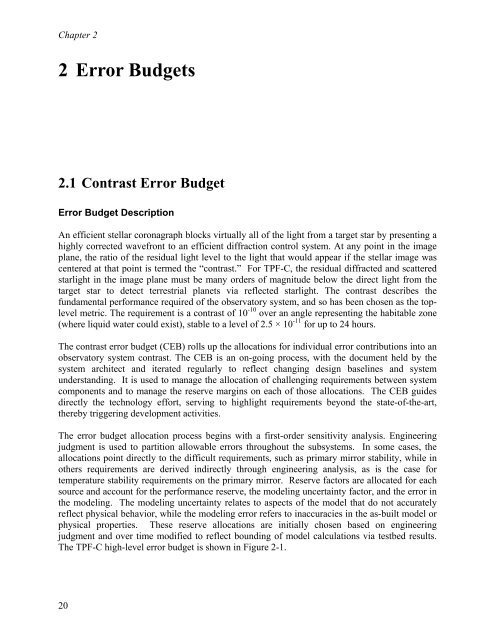TPF-C Technology Plan - Exoplanet Exploration Program - NASA
TPF-C Technology Plan - Exoplanet Exploration Program - NASA
TPF-C Technology Plan - Exoplanet Exploration Program - NASA
Create successful ePaper yourself
Turn your PDF publications into a flip-book with our unique Google optimized e-Paper software.
Chapter 2<br />
2 Error Budgets<br />
2.1 Contrast Error Budget<br />
Error Budget Description<br />
An efficient stellar coronagraph blocks virtually all of the light from a target star by presenting a<br />
highly corrected wavefront to an efficient diffraction control system. At any point in the image<br />
plane, the ratio of the residual light level to the light that would appear if the stellar image was<br />
centered at that point is termed the “contrast.” For <strong>TPF</strong>-C, the residual diffracted and scattered<br />
starlight in the image plane must be many orders of magnitude below the direct light from the<br />
target star to detect terrestrial planets via reflected starlight. The contrast describes the<br />
fundamental performance required of the observatory system, and so has been chosen as the toplevel<br />
metric. The requirement is a contrast of 10 -10 over an angle representing the habitable zone<br />
(where liquid water could exist), stable to a level of 2.5 × 10 -11 for up to 24 hours.<br />
The contrast error budget (CEB) rolls up the allocations for individual error contributions into an<br />
observatory system contrast. The CEB is an on-going process, with the document held by the<br />
system architect and iterated regularly to reflect changing design baselines and system<br />
understanding. It is used to manage the allocation of challenging requirements between system<br />
components and to manage the reserve margins on each of those allocations. The CEB guides<br />
directly the technology effort, serving to highlight requirements beyond the state-of-the-art,<br />
thereby triggering development activities.<br />
The error budget allocation process begins with a first-order sensitivity analysis. Engineering<br />
judgment is used to partition allowable errors throughout the subsystems. In some cases, the<br />
allocations point directly to the difficult requirements, such as primary mirror stability, while in<br />
others requirements are derived indirectly through engineering analysis, as is the case for<br />
temperature stability requirements on the primary mirror. Reserve factors are allocated for each<br />
source and account for the performance reserve, the modeling uncertainty factor, and the error in<br />
the modeling. The modeling uncertainty relates to aspects of the model that do not accurately<br />
reflect physical behavior, while the modeling error refers to inaccuracies in the as-built model or<br />
physical properties. These reserve allocations are initially chosen based on engineering<br />
judgment and over time modified to reflect bounding of model calculations via testbed results.<br />
The <strong>TPF</strong>-C high-level error budget is shown in Figure 2-1.<br />
20
















